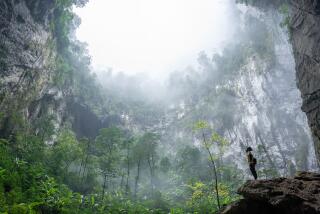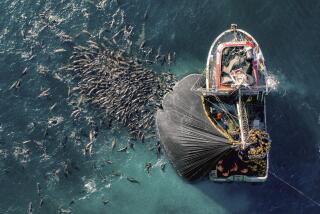The precarious nature of things
- Share via
Despite its cheery yellow borders and air of family fun and wide-eyed wonder, National Geographic magazine is a sobering read nowadays, unflinching in its coverage of a world in crisis, detailed in full-color spreads of endangered species and despoiled landscapes. To be sure, it also continues to run stories about pirate treasure and exotic lands, but I have learned, if I am in a sensitive mood, to approach it with caution.
As much is true of “National Geographic’s Strange Days on Planet Earth,” beginning tonight on PBS -- a valuable series, but tough sledding, despite its “exciting” visual style and odd rays of hope. Its subject is ecological balance, fine-tuned across millenniums and upset by accelerating change in a shrinking world, pumped full of synthetic compounds whose effects are as poorly understood as their immediate usefulness is obvious. There’s no more important or critical subject, this being the subject that contains all other subjects. Time, in this matter, does not grow any less of the essence.
The four episodes deal in turn with alien species (plants and animals living where they don’t belong), global warming, the consequences of the elimination of large predators, and the poisoning of the water supply. Their common theme is that all these damaging events are being helped along, if not entirely driven by, homo supposedly sapiens. “Humans expand, nature contracts,” says one of the series’ many scientist-heroes. “The obvious endpoint of that is a world without nature.”
“For every voice of doom, someone else will tell you that the planet is doing pretty well, thank you,” says narrator-host Edward Norton, though nothing that follows particularly supports the latter assertion. It may be “responsible journalism” to acknowledge a range of opinion, but here it has a hollow ring of preemptory appeasement. The narration is careful to say that the havoc wreaked upon the natural world has been done with “the best intentions,” and that it’s “without realizing it” that “we’ve turned up the global thermometer.”
“In this confusing era,” Norton says, “only one thing is certain -- these are strange days on Planet Earth.”
This strangeness includes South Formosan subterranean termites chewing up New Orleans; leopard frogs, a successful breed for 200 million years, turning hermaphroditic; cancerous Beluga whales, some “so full of toxins that they technically qualify as hazardous waste”; and rising rates of asthma in Trinidad correlating to African dust storms, driven west by changing wind patterns over the North Atlantic, the result of the warming of the Indian Ocean. The series is all about connections -- of warmer Arctic temperatures increasing the mosquito population, which drives the caribou into the hills where food is scarce (result: fewer caribou). It links the loss of certain forests in Yellowstone to the expulsion of the gray wolf (whose removal emboldened foraging elk); increasing rates of malaria along the Ugandan shoreline of Lake Victoria to the importation of Brazilian water hyacinths; and soil erosion in Hawaii to the Mexican miconia, escaped from private yards into the jungle.
The series is lighted and shot like a movie, possibly because people seem to be more receptive to what looks like fiction than to simple fact. There are special effects and split screens, pixilation and dramatic re-creation. Each episode opens like a disaster movie, with helicopter flyovers, tracking shots and action music to create a sense of excitement and dread. Norton narrates from a variety of Southern California locations, though we find him mostly on a featureless suburban cul-de-sac, selected perhaps to represent the ceaseless fall of open land to development. Shots of Norton looking pensive come across as staged, an actor’s pose. Real scientists are made to look glossily unreal.
Happily, as they represent the best hope for the rest of us, they are quite actual. Here is Tyrone Hayes of UC Berkeley, with his long earring and a ponytail, listening to the frogs; and James Ogwang, clearing the Ugandan shoreline with carefully vetted weevils; and Doug Smith, putting wolves back into Yellowstone. One thing leads to another: The wolves keep the elk on the run, and the forests have begun to return.
*
‘National Geographic’s Strange Days on Planet Earth’
Where: KCET
When: 9 tonight
Ratings: TV-PG (may be unsuitable for young children)
Edward Norton...Host
Executive producers Mark Shelley and Nancy Burnett.
More to Read
The complete guide to home viewing
Get Screen Gab for everything about the TV shows and streaming movies everyone’s talking about.
You may occasionally receive promotional content from the Los Angeles Times.







